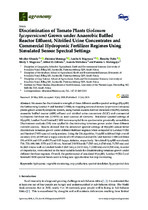| dc.description.abstract | We assess the discriminative strength of three different satellite spectral settings (HyspIRI, the forthcoming Landsat 9 and Sentinel 2-MSI), in mapping tomato (Solanum lycopersicum Linnaeus) plants grown under hydroponic system, using human-excreta derived materials (HEDM), namely, anaerobic baffled reactor (ABR) effluent and nitrified urine concentrate (NUC) and commercial hydroponic fertilizer mix (CHFM) as main sources of nutrients. Simulated spectral settings of HyspIRI, Landsat 9 and Sentinel 2-MSI were resampled from spectrometric proximally sensed data. Discriminant analysis (DA) was applied in discriminating tomatoes grown under these different nutrient sources. Results showed that the simulated spectral settings of HyspIRI sensor better discriminate tomatoes grown under different fertilizer regimes when compared to Landsat 9 OLI and Sentinel-2 MSI spectral configurations. Using the DA algorithm, HyspIRI exhibited high overall accuracy (OA) of 0.99 and a kappa statistic of 0.99 whereas Landsat OLI and Sentinel-2 MSI exhibited OA of 0.94 and 0.95 and 0.79 and 0.85 kappa statistics, respectively. Simulated HyspIRI wavebands 710, 720, 690, 840, 1370 and 2110 nm, Sentinel 2-MSI bands 7 (783 nm), 6 (740 nm), 5 (705 nm) and 8a (865 nm) as well as Landsat bands 5 (865 nm), 6 (1610 nm), 7 (2200 nm) and 8 (590 nm), in order of importance, were selected as the most suitable bands for discriminating tomatoes grown under different fertilizer regimes. Overall, the performance of simulated HyspIRI, Landsat 9 OLI-2 and Sentinel-2 MSI spectral bands seem to bring new opportunities for crop monitoring. | en_US |

